2019–20 Annual Report on the Administration of the Access to Information Act
Table of contents
- Introduction
- About the OIC
- 2019–20 Statistics and Trends
- Appendix A: Delegation Order, Access to Information Act
- Appendix B: Delegation Order, Information Commissioner Ad Hoc
- Appendix C: 2019–20 Statistical Report
Introduction
The purpose of the Access to Information Act (Act) is to protect the public’s right to access records under the control of government institutions, while ensuring that the use of exemptions and exclusions is limited and specific. The Act also specifies that any decisions on the disclosure of information should be reviewed independently of government. To this end, the Office of the Information Commissioner (OIC) was established under the Act in 1983 to support the Information Commissioner in her role as an independent oversight body reporting to Parliament.
When the OIC became subject to the Access to Information on April 1, 2007, the organization committed to providing exemplary service to requesters seeking information about its investigations and operations.
The OIC has consistently lived up to that commitment, quickly responding to requests and disclosing a broad range of information.
The Service Fees Act requires a responsible authority to report annually to Parliament on the fees collected by the institution.
With respect to fees collected under the Access to Information Act, the information below is reported in accordance with the requirements of section 20 of the Service Fees Act.
The OIC has been waiving all fees, including the $5 application fee, since 2011. As there were 42 requests received under the Act, the OIC has waived $210 in application fees. The total operating costs for the year were $136,308.
This report, prepared and tabled in accordance with section 94 of the Access to Information Act, reviews the OIC’s access to information activities for 2019–20.
2019–20 access highlights
- The OIC carried two requests over into 2019–20 from the previous year.
- We received 42 new requests and completed 43 requests prior to year-end.
- 100% of requests were completed within statutory deadlines.
- The average time to complete a request was 21.25 days.
- There were no complaints regarding how the OIC handled access requests.
About the OIC
The Office of the Information Commissioner (OIC) was established in 1983 under the Access to Information Act to support the mandate of the Information Commissioner of Canada.
OIC staff carry out confidential investigations into complaints about federal institutions’ handling of access requests, giving both complainants and institutions the opportunity to present their positions.
The OIC strives to maximize compliance with the Act, using the full range of tools, activities and powers at the Commissioner’s disposal. These include negotiating with complainants and institutions without the need for formal investigations, making formal recommendations to resolve matters at the conclusion of investigations, and bringing cases to the Federal Court to ensure the Act is properly applied and interpreted.
The OIC supports the Information Commissioner in her advisory role to Parliament and parliamentary committees on all matters pertaining to access to information. The OIC also raises awareness regarding the right of access in Canada through targeted initiatives such as Right to Know Week and ongoing dialogue with Canadians, Parliament and federal institutions.
The Commissioner is supported by a staff complement of approximately 115 employees, including a senior management team of three deputy commissioners:
- Deputy Commissioner, Investigations and Governance
- Deputy Commissioner, Legal Services and Public Affairs
- Deputy Commissioner, Corporate Services, Strategic Planning and Transformation Services
The Access to Information and Privacy Secretariat falls under the Legal Services and Public Affairs Branch. The ATIP Manager and the Deputy Commissioner of Legal Services and Public Affairs hold full delegated authority under the Act. A copy of the delegation order is included at Appendix A of this report.
The OIC has a small team of specialists who carry out the organization’s access to information and privacy (ATIP) activities. In 2019–20, the ATIP Secretariat was comprised of the ATIP Manager (full-time) supported by a full-time ATIP Analyst and a part-time student.
Secretariat staff process requests, provide training on access and privacy matters to new staff, and develop and implement policies and procedures.
Information Commissioner Ad Hoc
Requesters who are of the view that the OIC has improperly handled their access request are entitled to file a complaint. To prevent any conflict of interest and to ensure the integrity of the complaint process, the Information Commissioner Ad Hoc investigates complaints regarding access requests submitted to the OIC.
Anne E. Bertrand was appointed as Commissioner Ad Hoc on June 1, 2018. The Commissioner Ad Hoc has the same powers and obligations as the Information Commissioner with respect to conducting investigations and making recommendations. Appendix B contains the delegation order that was in effect for Ms. Bertrand in 2019–20.
2019–20 Statistics and Trends
Appendix C contains the OIC’s statistical report on the Access to Information Act for 2019–20. The following sets out some highlights from that report, along with notable trends related to workload, timeliness and disclosure over the years the OIC has been subject to the Act.
Workload highlights, 2019–20 Requests carried over from 2018–19 3 New requests 42 Requests completed 43 Requests carried over to 2020–21 2 Number of pages processed 27,701 Informal requests received and completed 4 Consultation requests received and completed 8
Workload
The OIC received 42 new requests in 2019–20. This represents a 32% decrease from the 62 requests received in 2018–19. There were three requests carried over from 2018–19, and two requests have been carried over to 2020-21.
The COVID-19 measures undertaken March 13, 2020, had minimal impact on our operations as all ATIP staff were equipped to work remotely and there was no interruption in service.
As Figure 1 shows, the annual volume of requests has fluctuated over the past five years. There was a surge in 2015-16, followed by a drop in 2016-17. The year 2019–20 represents a decrease of 32% from the previous year.
|
Requests carried over from 2018–19 |
3 |
|
New requests |
42 |
|
Requests completed |
43 |
|
Requests carried over to 2020–21 |
2 |
|
Number of pages processed |
27,701 |
|
Informal requests received and completed |
4 |
|
Consultation requests received and completed |
8 |
Figure 1: New requests, 2015–16 to 2019–20
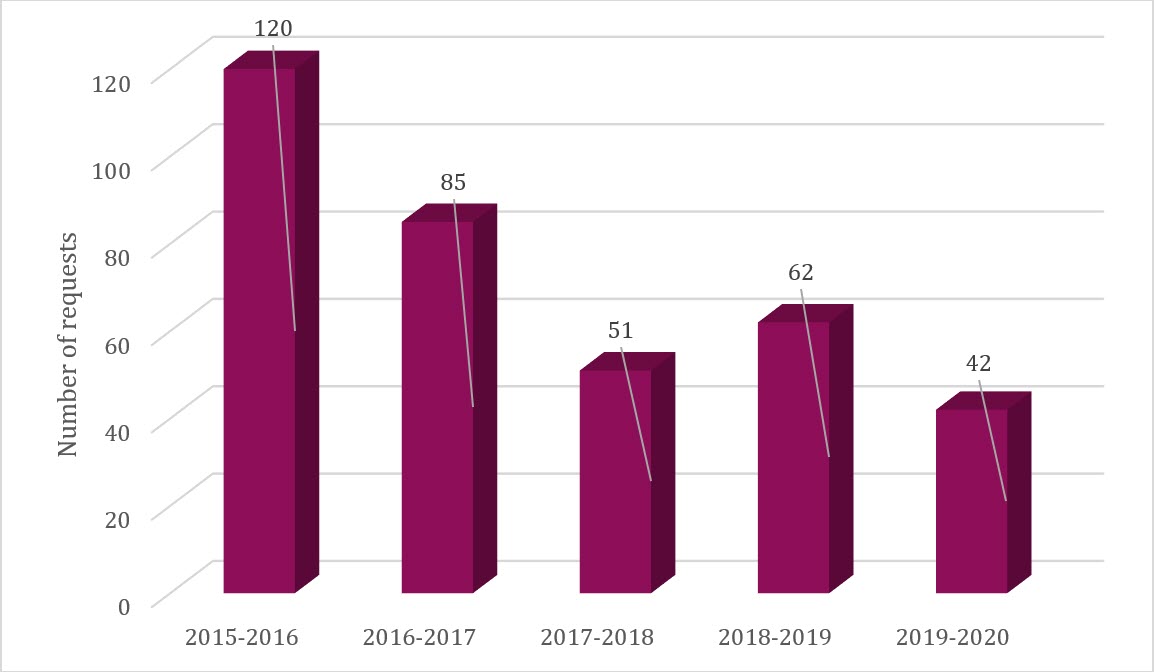
Text version
This bar graph shows the number of new requests the Office of the Information Commissioner (OIC) received each year between 2015–2016 and 2019–2020, as follows:
- In 2015–2016, the OIC received 120 requests.
- In 2016–2017, the OIC received 85 requests.
- In 2017–2018, the OIC received 51 requests.
- In 2018–2019, the OIC received 62 requests.
- In 2019–2020, the OIC received 42 requests.
Over the years, statistics have indicated that the OIC receives the majority of requests from the public. With the exception of the first two years that the organization was subject to the Act, individual members of the public have always been the most frequent requesters, accounting for 55% or more of new requests each year. In both 2007–08 and 2008–09, businesses were the source of most requests.
In 2019–20, the greatest portion of the new requests in 2019–20 were from members of the public (62%). Members of the media or businesses submitted nearly all the remaining requests.
Given the OIC’s work investigating complaints, the OIC receives numerous requests related to complaints each year. In 2019–20, the OIC received 16 such requests out of 42 requests (38%). The second largest proportion of requests was for call-ups or contracts. This accounted for 11 requests (26%). The remaining requests were for various records including correspondence, briefing notes and information regarding Bill C-58.
Examples of new access requests, 2019–20
- Investigation files or documents related to investigations
- Briefing materials prepared for the Commissioner
- Call-ups for services against government standing offers and other contracting instruments
- Government work description and position
- Bill C-58
- Access to Information Act reform
Figure 2: Number of pages processed, 2015–16 to 2019–20
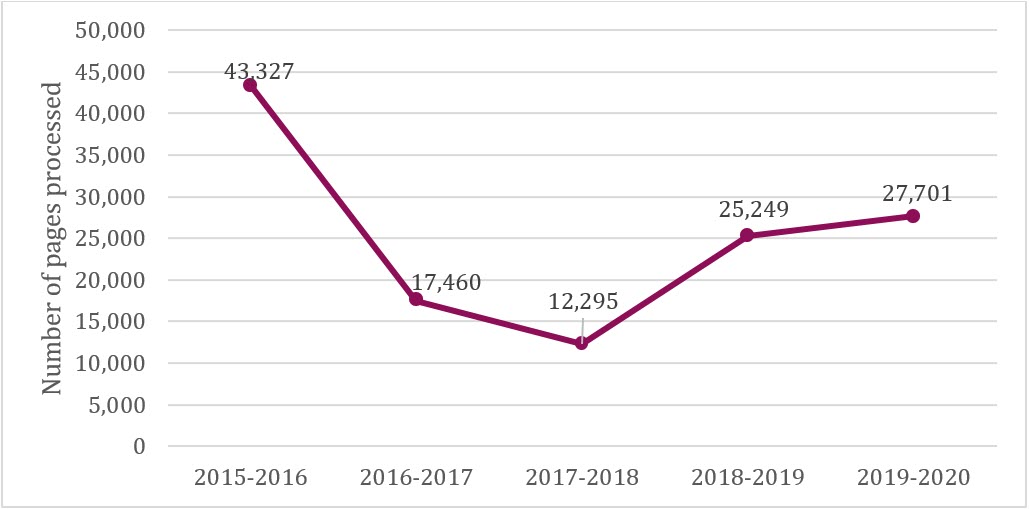
Text version
This fever chart shows the number of pages the Office of the Information Commissioner (OIC) processed for the requests it completed each year from 2015–2016 to 2019–20, as follows:
- In 2015–2016, the OIC processed 43,327 pages.
- In 2016–2017, the OIC processed 17,460 pages.
- In 2017–2018, the OIC processed 12,295 pages.
- In 2018–2019, the OIC processed 25,249 pages.
- In 2019–20, the OIC processed 27,701 pages.
In 2019–20, the OIC processed 27,701 pages. This represents a 2% increase from 2018‑19.
In 2019–20, five requests (12%) required the processing of more than 1,000 pages, totalling 18,776 pages processed. In comparison six requests (10%) in 2018–19 required the processing of more than 1,000 pages, totalling 17,246 pages processed. While the number of voluminous files decreased, the volume per file increased by 880 pages per file.
In addition to formal access requests, the OIC receives informal requests each year. These are often requests for records that had been previously released. The OIC responded to 4 such requests in 2019–20, processing a total of 2,578 pages. This is in addition to the 27,701 pages treated in response to formal requests.
The final component of the OIC’s access request-related workload is consultations—that is, when other institutions seek the OIC’s input on requests they have received that touch on the OIC’s business or involve its records. Institutions generally ask for recommendations on whether any information should be exempted from release. The OIC’s general practice is to not provide recommendations on the application of exemptions in response to consultation requests. This is because the Commissioner could later be required to investigate complaints about the institution’s use of those provisions of the Act to withhold information. Not making recommendations allows the Commissioner to maintain impartiality and avoid conflicts of interest.
The OIC nonetheless received 8 requests for consultations in 2019–20. This represents a decrease from the 14 such requests in 2018–19.
Timeliness
A hallmark of exemplary service to requesters is timeliness. Indeed, responding to access requests as promptly as possible underpins the entire access system.
Figure 3: Completion time for access requests, 2019–20
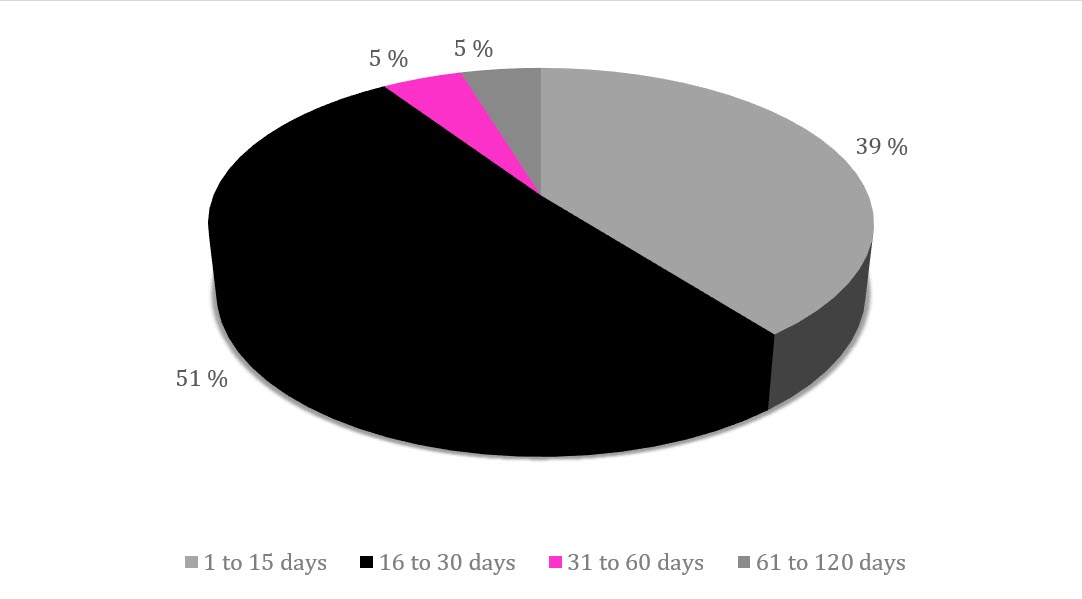
Text version
This pie chart sets out the time it took the Office of the Information Commissioner to complete 43 requests in 2019–2020. The Office of the Information Commissioner completed 39 percent of these requests in 15 days or less; 51 percent in 16 to 30 days; 5 percent in 31 to 60 days; and 5 percent in 61 to 120 days.
The Access to Information Act sets 30 days as the timeframe within which institutions should respond to requests. When institutions determine that they will be unable to complete a request in 30 days, they may take a time extension. In keeping with the principle of timeliness, the OIC strives to make these extensions as short as possible.
File status is monitored on an ongoing basis by all members of the ATIP team to ensure that all files are answered within statutory deadlines. This is done through regular reports drawn from our case management system.
Of the 43 requests the OIC closed in 2019–20, 90% were completed in less than 30 days (Figure 3), 39% in 15 days or less, and 51% in 16 to 30 days.
In 2019–20, the OIC took four time extensions to respond to requests. Two of these were for 31 to 60 days, and two were for 61 to 120 days. Two of the four extensions taken were to complete consultations with other organizations.
The OIC completed all 42 requests in 2019–20 before their deadline (either 30 days or the extended date), such that the OIC had no “deemed refusals.” Footnote 1
Figure 4: Average completion time for requests, 2015–16 to 2019–20
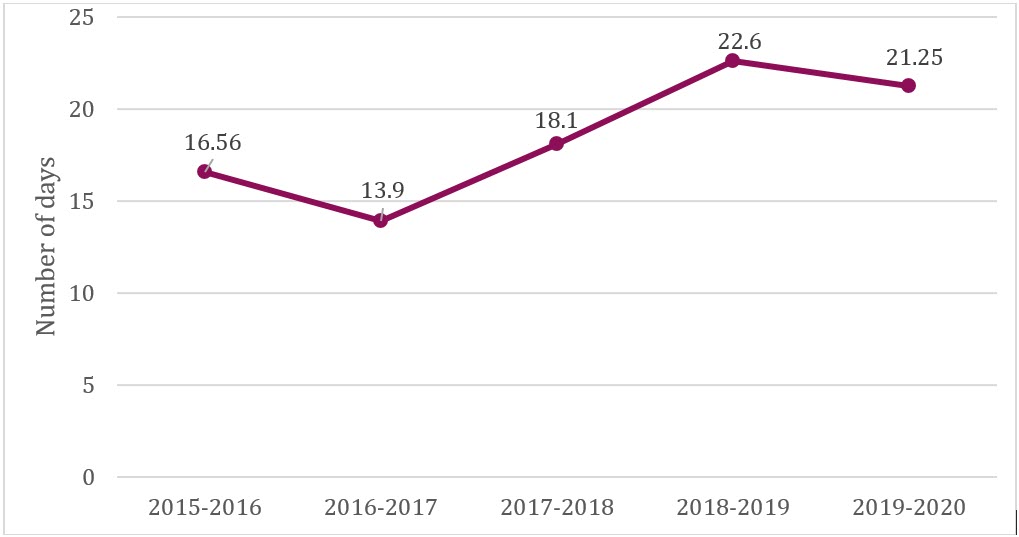
Text version
This fever chart shows the average time the Office of the Information Commissioner took to complete requests each year from 2015–2016 to 2019–20, as follows: 16.56 days (2015–2016); 13.9 days (2016–2017); 18.1 days (2017–2018); 22.6 days (2018–2019); and 21.25 days (2019–2020).
Another measure of timeliness is the average time it takes to complete a request.
The OIC’s average completion time for requests for 2019–20 was 21.25 days. This is well below the 30-day time limit set out in the Act.
As Figure 4 shows, in the last five years, the OIC has consistently achieved an average completion time of less than 30 days.
Disclosure
The purpose of the Access to Information Act is to protect the right to access records under the control of government institutions, while ensuring that the use of any exemptions and exclusions is limited and specific. In line with this purpose, the OIC seeks to release as much information as possible to requesters and withhold only what the law requires.
In 2019–20, the OIC disclosed all the records in response to 11 requests (26% of the 43 files completed, a 2% decrease from 2018–19). These included requests for annual statistics, lists of briefing notes and routine procurement records.
The OIC released part of the information requested for 20 files (47%). In many of these cases, the requests were related to investigations. The OIC cannot release any investigation records before an investigation is complete and the complaint closed, and only some afterwards, as set out in section 16.1 of the Act. Figure 5 provides a five-year trend.
Disposition of completed requests, 2019–20
|
Disposition |
Number of requests |
|---|---|
|
All disclosed |
11 (26%) |
|
Disclosed in part |
20 (47%) |
|
All exempted |
0 (0%) |
|
No records exist |
11 (26%) |
|
Request transferred |
0 (0%) |
|
Request abandoned |
1 (1%) |
|
Total |
43 (100%)* |
*The percentages total slightly more than 100 due to rounding.
Figure 5: Disclosure of records, 2015–16 to 2019–20
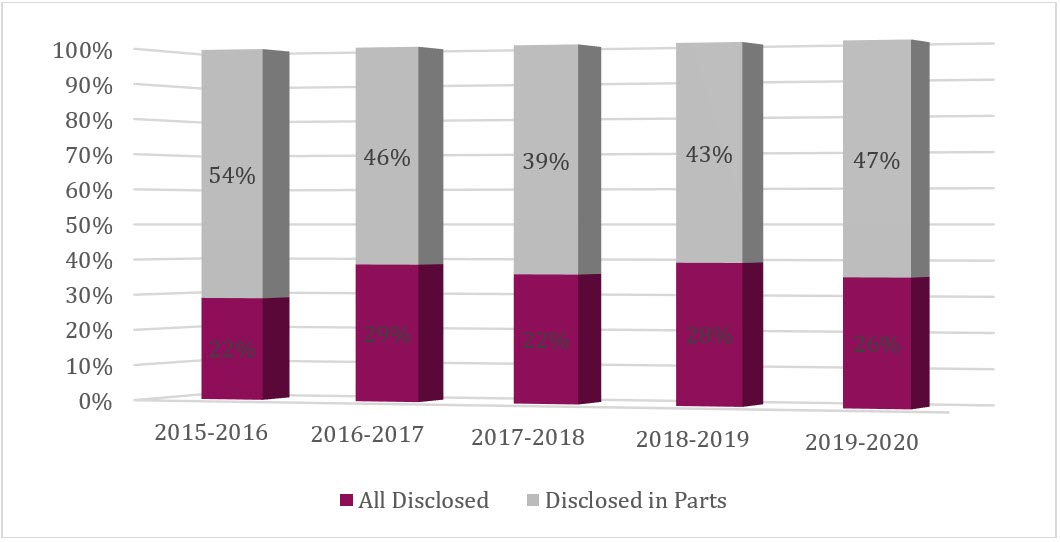
Text version
This bar chart shows the percentage of requests the Office of the Information Commissioner completed between 2015–2016 and 2019–20 for which all records were disclosed and for which records were disclosed in part, as follows:
- 2015–2016: 22 percent all disclosed; 54 percent disclosed in part.
- 2016–2017: 29 percent all disclosed; 46 percent disclosed in part.
- 2017–2018: 22 percent all disclosed; 39 percent disclosed in part.
- 2018–2019: 28 percent all disclosed; 43 percent disclosed in part.
- 2019–20: 26 percent all disclosed; 47 percent disclosed in part.
In 2019–20, the OIC received 11 new requests where no records were found. This represents 26% of the total request volume, which is a slight increase with the proportion seen in 2018–19.
Exemptions Claimed, 2019–20
The OIC claimed 5 different exemptions and 0 exclusion to sever information when responding to requests in 2019–20 throughout the 20 files where information was redacted.
Paragraph 16.1(1)(c) of the Act, which specifically exempts records associated with the OIC’s investigations, was invoked in 13 of the 20 files where information was withheld. This is a mandatory exemption.
Unlike previous years however, paragraph 16.1(1)(c) was the OIC’s most commonly claimed exemption during this reporting period. Subsection 19(1),which requires the severance of personal information, was the second-most used exemption, having been invoked in 9 of 20 files. This is also a mandatory exemption.
The Act also excludes certain information, such as Cabinet confidences (section 69). This exclusion was not applied in any request in 2019–20.
Complaints
In 2019–20, the Information Commissioner Ad Hoc did not receive any complaints about the OIC’s handling of access requests.
The annual report of the Information Commissioner Ad Hoc will be published along with the Commissioner’s annual report.
Access to information activities at the OIC
The OIC has a small team of specialists who carry out the organization’s access to information and privacy (ATIP) activities. In 2019–20, the ATIP Secretariat was comprised of the ATIP Manager (full-time) supported by a full-time ATIP Analyst and a part-time student.
Secretariat staff process requests, provide ongoing training on access and privacy matters to staff, and develop and implement policies and procedures. No new policies, guidelines, procedures or initiatives were implemented during the reporting period.
In 2019–20, the Secretariat held formal training sessions for all new employees. A total of 23 employees participated in these sessions. There were also informal training sessions on an ad hoc basis with current employees as required.
Appendix A: Delegation Order, Access to Information Act
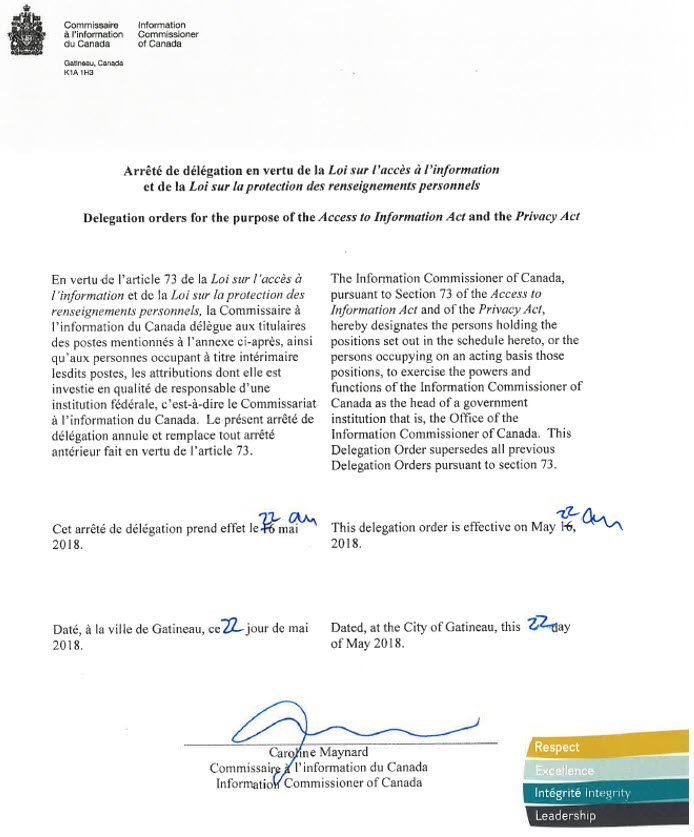
Text version
Arrêté de délégation en vertu de la Loi sur l’accès à l’information et de la Loi sur la protection des renseignements personnels
Delegation orders for the purpose of the Access to Information Act and the Privacy Act
En vertu de l’article 73 de la Loi sur l’accès à l’information et de la Loi sur la protection des renseignements personnels, la Commissaire à l’information du Canada délègue aux titulaires des postes mentionnés à l’annexe ci-après, ainsi qu’aux personnes occupant à titre intérimaire lesdits postes, les attributions dont elle est investie en qualité de responsable d’une institution fédérale, c’est-à-dire le Commissariat à l’information du Canada. Le présent arrêté de délégation annule et remplace tout arrêté antérieur fait en vertu de l’article 73.
Cet arrêté de délégation prend effet le 22 mai 2018.
Daté, à la ville de Gatineau, ce 22 jour de mai 2018
Original signé par
The Information Commissioner of Canada, pursuant to Section 73 of the Access to Information Act and of the Privacy Act, hereby designates the persons holding the positions set out in the schedule hereto, or the persons occupying on an acting basis those positions, to exercise the powers and functions of the Information Commissioner of Canada as the head of a government institution that is, the Office of the Information Commissioner of Canada. This Delegation Order supersedes all previous Delegation Orders pursuant to section 73.
This delegation order is effective on May 22, 2018
Dated, at the City of Gatineau, this 22 day of May 2018
Original signed by
______________________________________________
Caroline Maynard
Commissaire à l’information du Canada
Information Commissioner of Canada
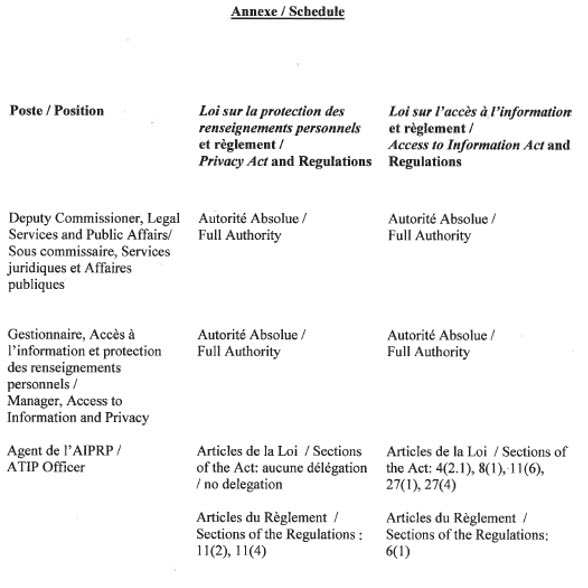
Text version
| Schedule / Annexe | ||
| Position / Poste | Privacy Actand Regulations/Loi sur la protection des renseignements personnelset règlement. | Access to Information Act and Regulations/Loi sur l’accès à l’informationet règlement. |
| Deputy Commissioner, Legal Services and Public Affairs/ Sous commissaire, Services juridiques et Affaires publiques | Autorité Absolue / Full Authority | Autorité Absolue / Full Authority |
| Gestionnaire, Accès à l’information et protection des renseignements personnels / Manager, Access to Information and Privacy | Autorité Absolue / Full Authority | Autorité Absolue / Full Authority |
| Agent de l’AIPRP / ATIP Officer | Articles de la Loi / Sections of the Act : aucune délégation no delegation Articles du Règlement / Sections of the Regulations : 11(2), 11(4) | Articles de la loi / Sections of the Act : 4(2.1), 8(1), 11(6), 27(1), 27(4). Articles du Règlement / Sections of the Regulations : 6(1) |
Appendix B: Delegation Order, Information Commissioner Ad Hoc
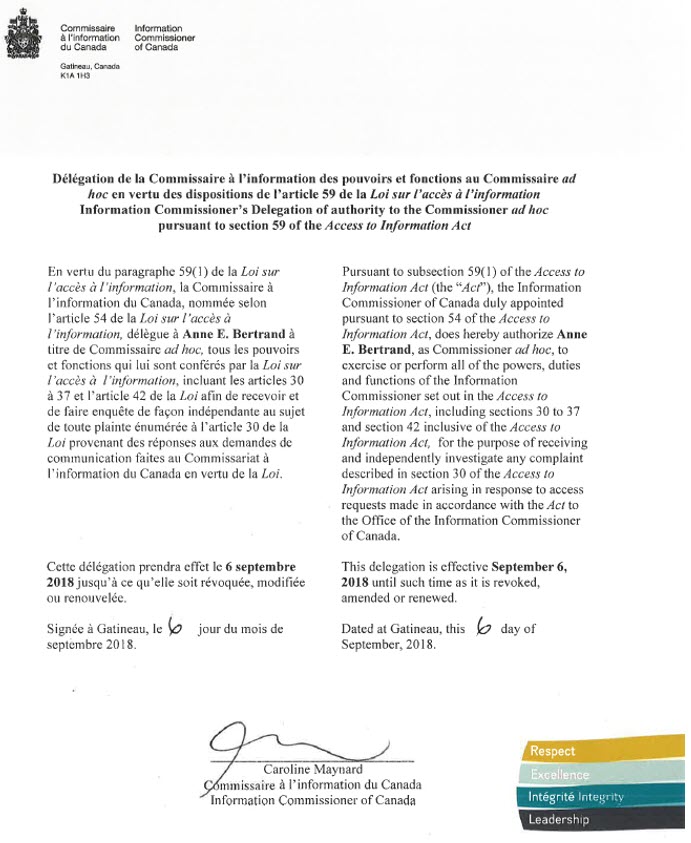
Text version
Délégation du Commissaire à l’information des pouvoirs et fonctions au Commissaire ad hoc en vertu des dispositions de l’article 59 de la Loi sur l’accès à l’information
Information Commissioner’s Delegation of authority to the Commissioner ad hoc pursuant to section 59 of the Access to Information Act
| En vertu des dispositions de l’article 59(1) de la Loi sur l’accès à l’information, le Commissaire à l’information du Canada, nommé selon l’article 54 de la Loi sur l’accès à l’information, délègue à Anne E. Bertrand à titre de Commissaire ad hoc, tous les pouvoirs et fonctions qui lui sont conférés par la Loi sur l’accès à l’information, incluant les articles 30 à 37 et l’article 42 de la Loi afin de recevoir et de faire enquête de façon indépendante au sujet de toute plainte énumérée à l’article 30 de la Loi provenant des réponses aux demandes de communication faites au Commissariat à l’information du Canada en vertu de la Loi. | Pursuant to subsection 59(1) of the Access to Information Act (the “Act”), the Information Commissioner of Canada duly appointed pursuant to section 54 of the Access to Information Act, does hereby authorize Anne E. Bertrand, as Commissioner ad hoc, to exercise or perform all of the powers, duties and functions of the Information Commissioner set out in the Access to Information Act, including sections 30 to 37 and section 42 inclusive of the Access to Information Act, for the purpose of receiving and independently investigate any complaint described in section 30 of the Access to Information Act arising in response to access requests made in accordance with the Act to the Office of the Information Commissioner of Canada. |
| Cette délégation prendra effet le 6 septembre 2018 jusqu’à ce qu’elle soit révoquée, modifiée ou renouvelée. | This delegation is effective September 6, 2018 until such time as it is revoked, amended or renewed. |
| Signée à Gatineau, le 6 jour du mois de septembre 2018 | Dated at Gatineau, 6 day of September, 2018 |
| Original signé par | Original signed by |
______________________________
Caroline Maynard
Commissaire à l’information du Canada
Information Commissioner of Canada
Appendix C: 2018–19 Statistical Report
Statistical Report on the Access to Information Act
Name of institution: Office of the Information Commissioner of Canada
Reporting period: 2019-04-01 to 2020-03-31
Section 1: Requests under the Access to Information Act
1.1 Number of requests
| Number of requests | |
|---|---|
| Received during reporting period | 42 |
| Outstanding from previous reporting period | 3 |
| Total | 45 |
| Closed during reporting period | 43 |
| Carried over to next reporting period | 2 |
1.2 Sources of requests
| Source | Number of requests |
|---|---|
| Media | 7 |
| Academia | 0 |
| Business (private sector) | 9 |
| Organization | 0 |
| Public | 26 |
| Decline to Identify | 0 |
| Total | 42 |
1.3 Informal requests
| Completion time | |||||||
|---|---|---|---|---|---|---|---|
| 1 to 15 days | 16 to 30 days | 31 to 60 days | 61 to 120 days | 121 to 180 days | 181 to 365 days | More than 365 days | Total |
| 4 | 0 | 0 | 0 | 0 | 0 | 0 | 4 |
Note: All requests previously recorded as “treated informally” will now be accounted for in this section only.
Section 2: Decline to act on vexatious, made in bad faith or abuse of right requests
| Number of Requests | |
|---|---|
| Outstanding from previous reporting period | 0 |
| Sent during reporting period | 0 |
| Total | 0 |
| Approved by the Information Commissioner during reporting period | 0 |
| Declined by the Information Commissioner during reporting period | 0 |
| Carried over to next reporting period | 0 |
Section 3: Requests closed during the reporting period
3.1 Disposition and completion time
| Disposition of requests | Completion time | |||||||
|---|---|---|---|---|---|---|---|---|
| 1 to 15 days | 16 to 30 days | 31 to 60 days | 61 to 120 days | 121 to 180 days | 181 to 365 days | More than 365 days | Total | |
| All disclosed | 5 | 6 | 0 | 0 | 0 | 0 | 0 | 11 |
| Disclosed in part | 6 | 10 | 2 | 2 | 0 | 0 | 0 | 20 |
| All exempted | 0 | 0 | 0 | 0 | 0 | 0 | 0 | 0 |
| All excluded | 0 | 0 | 0 | 0 | 0 | 0 | 0 | 0 |
| No records exist | 6 | 0 | 0 | 0 | 0 | 0 | 0 | 11 |
| Request transferred | 0 | 0 | 0 | 0 | 0 | 0 | 0 | 0 |
| Request abandoned | 0 | 1 | 0 | 0 | 0 | 0 | 0 | 1 |
| Neither confirmed nor denied | 0 | 0 | 0 | 0 | 0 | 0 | 0 | 0 |
| Decline to act with the approval of the Information Commissioner | 0 | 0 | 0 | 0 | 0 | 0 | 0 | 0 |
| Total | 17 | 22 | 2 | 2 | 0 | 0 | 0 | 43 |
3.2 Exemptions
| Section | Number of requests |
|---|---|
| 13(1)(a) | 0 |
| 13(1)(b) | 0 |
| 13(1)(c) | 0 |
| 13(1)(d) | 0 |
| 13(1)(e) | 0 |
| 14 | 0 |
| 14(a) | 0 |
| 14(b) | 0 |
| 15(1) | 0 |
| 15(1) - International Affairs | 0 |
| 15(1) - Defence of Canada | 0 |
| 15(1) - Subversive Activities | 0 |
| 16(1)(a)(i) | 0 |
| 16(1)(a)(ii) | 0 |
| 16(1)(a)(iii) | 0 |
| 16(1)(b) | 0 |
| 16(1)(c) | 0 |
| 16(1)(d) | 0 |
| 16(2) | 0 |
| 16(2)(a) | 0 |
| 16(2)(b) | 0 |
| 16(2)(c) | 1 |
| 16(3) | 0 |
| 16.1(1)(a) | 0 |
| 16.1(1)(b) | 0 |
| 16.1(1)(c) | 13 |
| 16.1(1)(d) | 0 |
| 16.2(1) | 0 |
| 16.3 | 0 |
| 16.4(1)(a) | 0 |
| 16.4(1)(b) | 0 |
| 16.5 | 0 |
| 17 | 0 |
| 18(a) | 0 |
| 18(b) | 0 |
| 18(c) | 0 |
| 18(d) | 0 |
| 18.1(1)(a) | 0 |
| 18.1(1)(b) | 0 |
| 18.1(1)(c) | 0 |
| 18.1(1)(d) | 0 |
| 19(1) | 9 |
| 20(1)(a) | 0 |
| 20(1)(b) | 0 |
| 20(1)(b.1) | 0 |
| 20(1)(c) | 3 |
| 20(1)(d) | 0 |
| 20.1 | 0 |
| 20.2 | 0 |
| 20.4 | 0 |
| 21(1)(a) | 0 |
| 21(1)(b) | 0 |
| 21(1)(c) | 0 |
| 21(1)(d) | 0 |
| 22 | 0 |
| 22.1(1) | 0 |
| 23 | 3 |
| 24(1) | 4 |
| 26 | 0 |
3.3 Exclusions
| Section | Number of requests |
|---|---|
| 68(a) | 0 |
| 68(b) | 0 |
| 68(c) | 0 |
| 68.1 | 0 |
| 68.2(a) | 0 |
| 68.2(b) | 0 |
| 69(1) | 0 |
| 69(1)(a) | 0 |
| 69(1)(b) | 0 |
| 69(1)(c) | 0 |
| 69(1)(d) | 0 |
| 69(1)(e) | 0 |
| 69(1)(f) | 0 |
| 69(1)(g) re (a) | 0 |
| 69(1)(g) re (b) | 0 |
| 69(1)(g) re (c) | 0 |
| 69(1)(g) re (d) | 0 |
| 69(1)(g) re (e) | 0 |
| 69(1)(g) re (f) | 0 |
| 69.1(1) | 0 |
3.4 Format of information released
| Paper | Electronic | Other |
|---|---|---|
| 9 | 22 | 0 |
3.5 Complexity
3.5.1 Relevant pages processed and disclosed
| Number of pages processed | Number of pages disclosed | Number of requests |
|---|---|---|
| 27701 | 20828 | 32 |
Note: The high volume of pages processed is due to the processing of three requests for voluminous audit files. Records for those three requests were not disclosed pursuant to Section 22.1 – Internal Audits
3.5.2 Relevant pages processed and disclosed by size of requests
| Disposition | Less than 100 pages processed |
101 to 500 pages processed |
501 to 1,000 pages processed |
1,001 to 5,000 pages processed |
More than 5,000 pages processed |
|||||
|---|---|---|---|---|---|---|---|---|---|---|
| Number of requests | Pages disclosed | Number of requests | Pages disclosed | Number of requests | Pages disclosed | Number of requests | Pages disclosed | Number of requests | Pages disclosed | |
| All disclosed | 11 | 189 | 0 | 0 | 0 | 0 | 0 | 0 | 0 | 0 |
| Disclosed in part | 10 | 411 | 3 | 273 | 2 | 1179 | 3 | 1313 | 2 | 17463 |
| All exempted | 0 | 0 | 0 | 0 | 1 | 0 | 0 | 0 | 3 | 0 |
| All excluded | 0 | 0 | 3 | 0 | 1 | 0 | 0 | 0 | 0 | 0 |
| Request abandoned | 1 | 0 | 0 | 0 | 0 | 0 | 0 | 0 | 0 | 0 |
| Neither confirmed nor denied | 0 | 0 | 0 | 0 | 0 | 0 | 0 | 0 | 0 | 0 |
| Total | 22 | 600 | 3 | 273 | 2 | 1179 | 3 | 1313 | 2 | 17463 |
3.5.3 Other complexities
| Disposition | Consultation required | Assessment of fees | Legal advice sought | Other | Total |
|---|---|---|---|---|---|
| All disclosed | 0 | 0 | 0 | 0 | 0 |
| Disclosed in part | 2 | 0 | 1 | 0 | 3 |
| All exempted | 0 | 0 | 0 | 0 | 0 |
| All excluded | 0 | 0 | 0 | 0 | 0 |
| Request abandoned | 0 | 0 | 0 | 0 | 0 |
| Neither confirmed nor denied | 0 | 0 | 0 | 0 | 0 |
| Total | 2 | 0 | 1 | 0 | 3 |
3.6 Closed requests
3.6.1 Number of requests closed within legislated timelines
| Requests closed within legislated timelines | |
|---|---|
| Number of requests closed within legislated timelines | 43 |
| Percentage of requests closed within legislated timelines (%) | 100 |
3.7 Deemed refusals
3.7.1 Reasons for not meeting statutory deadline
| Number of requests closed past the statutory deadline | Principal reason | |||
|---|---|---|---|---|
| Workload | External consultation | Internal consultation | Other | |
| 0 | 0 | 0 | 0 | 0 |
3.7.2 Requests closed beyond legislated timelines (including any extension taken)
| Number of days past deadline | Number of requests past deadline where no extension was taken | Number of requests past deadline where an extension was taken | Total |
|---|---|---|---|
| 1 to 15 days | 0 | 0 | 0 |
| 16 to 30 days | 0 | 0 | 0 |
| 31 to 60 days | 0 | 0 | 0 |
| 61 to 120 days | 0 | 0 | 0 |
| 121 to 180 days | 0 | 0 | 0 |
| 181 to 365 days | 0 | 0 | 0 |
| More than 365 days | 0 | 0 | 0 |
| Total | 0 | 0 | 0 |
3.8 Requests for translation
| Translation Requests | Accepted | Refused | Total |
|---|---|---|---|
| English to French | 0 | 0 | 0 |
| French to English | 0 | 0 | 0 |
| Total | 0 | 0 | 0 |
Section 4: Extensions
4.1 Reasons for extensions and disposition of requests
| Disposition of requests where an extension was taken | 9(1)(a) Interference with operations |
9(1)(b) Consultation |
9(1)(c) Third-party notice |
|
|---|---|---|---|---|
| Section 69 | Other | |||
| All disclosed | 0 | 0 | 0 | 0 |
| Disclosed in part | 2 | 0 | 0 | 2 |
| All exempted | 0 | 0 | 0 | 0 |
| All excluded | 0 | 0 | 0 | 0 |
| No records exist | 0 | 0 | 0 | 0 |
| Request abandoned | 0 | 0 | 0 | 0 |
| Total | 2 | 0 | 0 | 2 |
4.2 Length of extensions
| Length of extensions | 9(1)(a) Interference with operations |
9(1)(b) Consultation |
9(1)(c) Third-party notice |
|
|---|---|---|---|---|
| Section 69 | Other | |||
| 30 days or less | 0 | 0 | 0 | 0 |
| 31 to 60 days | 0 | 0 | 0 | 2 |
| 61 to 120 days | 2 | 0 | 0 | 0 |
| 121 to 180 days | 0 | 0 | 0 | 0 |
| 181 to 365 days | 0 | 0 | 0 | 0 |
| 365 days or more | 0 | 0 | 0 | 0 |
| Total | 2 | 0 | 0 | 2 |
Section 5: Fees
| Fee type | Fee collected | Fee waived or refunded | ||
|---|---|---|---|---|
| Number of requests |
Amount | Number of requests |
Amount | |
| Application | 0 | $0 | 43 | $215 |
| Other fees | 0 | $0 | 0 | $0 |
| Total | 0 | $0 | 43 | $215 |
Section 6: Consultations received from other institutions and organizations
6.1 Consultations received from other Government of Canada institutions and organizations
| Consultations | Other Government of Canada institutions | Number of pages to review | Other organizations | Number of pages to review |
|---|---|---|---|---|
| Received during reporting period | 8 | 0 | 0 | 0 |
| Outstanding from the previous reporting period | 0 | 0 | 0 | 0 |
| Total | 8 | 0 | 0 | 0 |
| Closed during the reporting period | 8 | 0 | 0 | 0 |
| Carried over to the next reporting period | 0 | 0 | 0 | 0 |
6.2 Recommendations and completion time for consultations received from other Government of Canada institutions
| Recommendation | Number of days required to complete consultation requests | |||||||
|---|---|---|---|---|---|---|---|---|
| 1 to 15 days | 16 to 30 days | 31 to 60 days | 61 to 120 days | 121 to 180 days | 181 to 365 days | More than 365 days | Total | |
| Disclose entirely | 0 | 0 | 0 | 0 | 0 | 0 | 0 | 0 |
| Disclose in part | 0 | 0 | 0 | 0 | 0 | 0 | 0 | 0 |
| Exempt entirely | 0 | 0 | 0 | 0 | 0 | 0 | 0 | 0 |
| Exclude entirely | 0 | 0 | 0 | 0 | 0 | 0 | 0 | 0 |
| Consult other institution | 0 | 0 | 0 | 0 | 0 | 0 | 0 | 0 |
| Other | 8 | 0 | 0 | 0 | 0 | 0 | 0 | 8 |
| Total | 8 | 0 | 0 | 0 | 0 | 0 | 0 | 8 |
6.3 Recommendations and completion time for consultations received from other organizations
| Recommendation | Number of days required to complete consultation requests | |||||||
|---|---|---|---|---|---|---|---|---|
| 1 to 15 days | 16 to 30 days | 31 to 60 days | 61 to 120 days | 121 to 180 days | 181 to 365 days | More than 365 days | Total | |
| Disclose entirely | 0 | 0 | 0 | 0 | 0 | 0 | 0 | 0 |
| Disclose in part | 0 | 0 | 0 | 0 | 0 | 0 | 0 | 0 |
| Exempt entirely | 0 | 0 | 0 | 0 | 0 | 0 | 0 | 0 |
| Exclude entirely | 0 | 0 | 0 | 0 | 0 | 0 | 0 | 0 |
| Consult other institution | 0 | 0 | 0 | 0 | 0 | 0 | 0 | 0 |
| Other | 0 | 0 | 0 | 0 | 0 | 0 | 0 | 0 |
| Total | 0 | 0 | 0 | 0 | 0 | 0 | 0 | 0 |
Section 7: Completion time of consultations on Cabinet confidences
7.1 Requests with Legal Services
| Number of days | Fewer than 100 pages processed | 101 to 500 pages processed | 501 to 1,000 pages processed |
1,001 to 5,000 pages processed |
More than 5,000 pages processed |
|||||
|---|---|---|---|---|---|---|---|---|---|---|
| Number of requests |
Pages disclosed | Number of requests |
Pages disclosed | Number of requests |
Pages disclosed | Number of requests |
Pages disclosed | Number of requests |
Pages disclosed | |
| 1 to 15 | 0 | 0 | 0 | 0 | 0 | 0 | 0 | 0 | 0 | 0 |
| 16 to 30 | 0 | 0 | 0 | 0 | 0 | 0 | 0 | 0 | 0 | 0 |
| 31 to 60 | 0 | 0 | 0 | 0 | 0 | 0 | 0 | 0 | 0 | 0 |
| 61 to 120 | 0 | 0 | 0 | 0 | 0 | 0 | 0 | 0 | 0 | 0 |
| 121 to 180 | 0 | 0 | 0 | 0 | 0 | 0 | 0 | 0 | 0 | 0 |
| 181 to 365 | 0 | 0 | 0 | 0 | 0 | 0 | 0 | 0 | 0 | 0 |
| More than 365 | 0 | 0 | 0 | 0 | 0 | 0 | 0 | 0 | 0 | 0 |
| Total | 0 | 0 | 0 | 0 | 0 | 0 | 0 | 0 | 0 | 0 |
7.2 Requests with Privy Council Office
| Number of days | Fewer than 100 pages processed | 101 to 500 pages processed | 501 to 1,000 pages processed |
1,001 to 5,000 pages processed |
More than 5,000 pages processed |
|||||
|---|---|---|---|---|---|---|---|---|---|---|
| Number of requests |
Pages disclosed | Number of requests |
Pages disclosed | Number of requests |
Pages disclosed | Number of requests |
Pages disclosed | Number of requests |
Pages disclosed | |
| 1 to 15 | 0 | 0 | 0 | 0 | 0 | 0 | 0 | 0 | 0 | 0 |
| 16 to 30 | 0 | 0 | 0 | 0 | 0 | 0 | 0 | 0 | 0 | 0 |
| 31 to 60 | 0 | 0 | 0 | 0 | 0 | 0 | 0 | 0 | 0 | 0 |
| 61 to 120 | 0 | 0 | 0 | 0 | 0 | 0 | 0 | 0 | 0 | 0 |
| 121 to 180 | 0 | 0 | 0 | 0 | 0 | 0 | 0 | 0 | 0 | 0 |
| 181 to 365 | 0 | 0 | 0 | 0 | 0 | 0 | 0 | 0 | 0 | 0 |
| More than 365 | 0 | 0 | 0 | 0 | 0 | 0 | 0 | 0 | 0 | 0 |
| Total | 0 | 0 | 0 | 0 | 0 | 0 | 0 | 0 | 0 | 0 |
Section 8: Complaints and investigations
| Section 32 Notice of intention to investigate | Subsection 30(5) Ceased to investigate | Section 35 Formal representations | Section 37 Reports of finding received | Section 37 Reports of finding containing recommendations issued by the Information Commissioner | Section 37 Reports of finding containing orders issued by the Information Commissioner |
|---|---|---|---|---|---|
| 0 | 0 | 0 | 0 | 0 | 0 |
Section 9: Court action
9.1 Court actions on complaints received before June 21, 2019 and on-going
| Section 41 (before June 21, 2019) | Section 42 | Section 44 |
|---|---|---|
| 0 | 0 | 0 |
9.2 Court actions on complaints received after June 21, 2019
| Section 41 (after June 21, 2019) | ||||
|---|---|---|---|---|
| Complainant (1) | Institution (2) | Third Party (3) | Privacy Commissioner (4) | Total |
| 0 | 0 | 0 | 0 | 0 |
Section 10: Resources related to the Access to Information Act
10.1 Costs
| Expenditures | Amount |
|---|---|
| Salaries | $136,140 |
| Overtime | $0 |
| Goods and Services | $168 |
| Professional services contracts | $0 |
| Other | $168 |
| Total | $136,308 |
10.2 Human Resources
| Resources | Person years dedicated to access to information activities |
|---|---|
| Full-time employees | 1.33 |
| Part-time and casual employees | 0.00 |
| Regional staff | 0.00 |
| Consultants and agency personnel | 0.00 |
| Students | 0.40 |
| Total | 1.73 |
New Exemptions Table
| Access to Information Act | |
|---|---|
| Section | Number of requests |
| 16.31 Investigation under the Elections Act | 0 |
| 16.6 National Security and Intelligence Committee | 0 |
| 23.1 Patent or Trademark privilege | 0 |
2019–20 Supplemental Statistical Report – Requests affected by COVID-19 measures
Supplemental Statistical Report on the Access to Information Act
The following table reports the total number of formal requests received during two periods: 2019-04-01 to 2020-03-13 and 2020-03-14 to 2020-03-31.
| Column (Col.) 1 Number of requests |
||
|---|---|---|
| Row 1 | Received from 2019-04-01 to 2020-03-13 | 42 |
| Row 2 | Received from 2020-03-14 to 2020-03-31 | 0 |
| Row 3 | Total1 | 42 |
1– Total for Row 3 should equal the total in the ATIA Statistical Report section 1.1 Row 1
The following table reports the total number of requests closed within the legislated timelines and the number of closed requests that were deemed refusals during two periods: 2019-04-01 to 2020-03-13 and 2020-03-14 to 2020-03-31.
| Col.1 Number of requests closed within the legislated timelines |
Col.2 Number of requests closed past the legislated timelines |
||
|---|---|---|---|
| Row 1 | Received from 2019-04-01 to 2020-03-13 and outstanding from previous reporting periods | 43 | 0 |
| Row 2 | Received from 2020-03-14 to 2020-03-31 | 0 | 0 |
| Row 3 | Total2 | 43 | 0 |
2 – Total for Row 3 Col. 1 should equal the total in the ATIA Statistical Report section 3.6.1 Row 1 -- Total for Row 3 Col. 2 should equal the total in the ATIA Statistical Report section 3.7.1. Col. 1 Row 1
The following table reports the total number of requests carried over during two periods: 2019-04-01 to 2020-03-13 and 2020-03-14 to 2020-03-31.
| Col. 1 Number of requests |
||
|---|---|---|
| Row 1 | Requests received from 2019-04-01 to 2020-03-13 and outstanding from previous reporting period that were carried over to the 2020-2021 reporting period | 2 |
| Row 2 | Requests received from 2020-03-14 to 2020-03-31 that were carried over to the 2020 to 2021 reporting period | 0 |
| Row 3 | Total3 | 2 |
3 – Total for Row 3 should equal the total in the ATIA Statistical Report section 1.1 Row